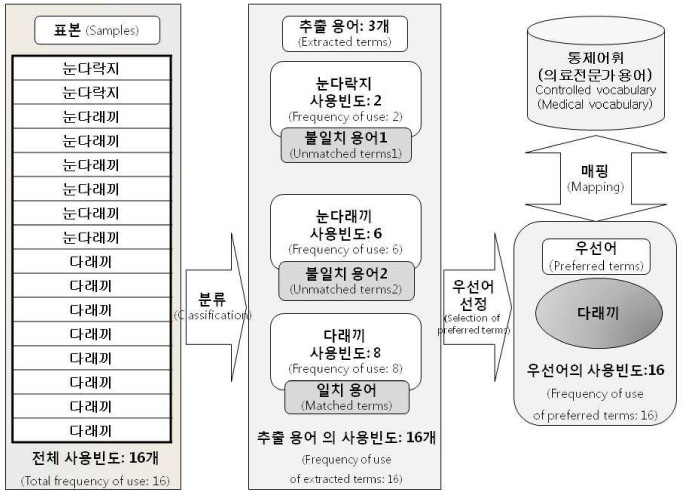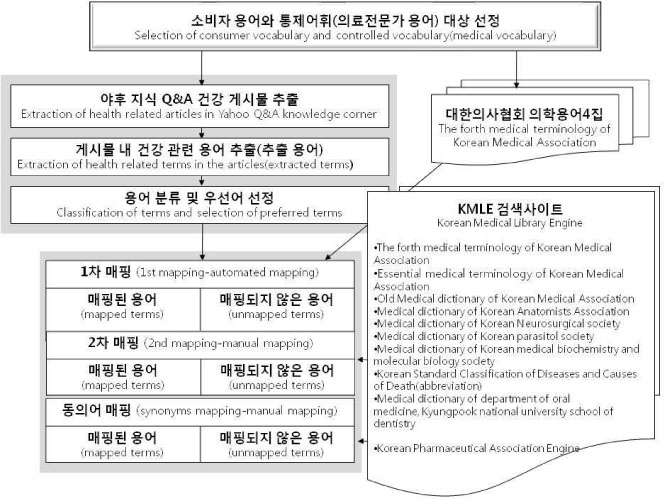J Korean Soc Med Inform.
2009 Mar;15(1):31-40.
A Study for Building a System of Consumer Vocabulary for Health Information
- Affiliations
-
- 1College of Nursing, Seoul National University, Korea. kim0424@snu.ac.kr
- 2Research Institute of Nursing Science, Seoul National University, Korea.
Abstract
OBJECTIVES
The purposes of this study were to identify the difference between consumer vocabulary and medical vocabulary in terms of health information; to understand the features of consumer vocabulary; and to contribute by building a system that is able to link consumer vocabulary with medical vocabulary.
METHODS
Data collection was conducted using articles in the knowledge corner of a portal web-site. A total of 43,304 health-related terms (total terms extracted) were collected as objects of this study and these terms were analyzed for their mapping rate and frequency of use (the repeated number of a term).
RESULTS
The rate of mapping between the consumer vocabulary for health information and the medical vocabulary was not high. However, the number of "unmapped terms" was decreased by linking terms having similar forms to "preferred terms" and by extending synonyms.
CONCLUSION
Linking with preferred terms and extending synonyms are, thus, required to increase the mapping rate between consumer vocabulary for health information and medical vocabulary, and the terms that consumers use are essential to further be researched in order to understand their morphology and features; hence, increasing consumer accessibility to the medical field.
Keyword
MeSH Terms
Figure
Reference
-
1. Tyson TR, Booth-Clibborn N, Oliver S. Consumer health information needs to be rigorous, complete, and relevant. BMJ. 2000. 321(7255):240.
Article2. Chi-Lum B. Consumers using the internet for medical information. J Med Pract Manage. 1999. 14:196–198.3. Zeng Qing, Tse Tony. Exploring and Developing Consumer Health Vocabularies. J Am Med Inform Assoc. 2006. 13(1):24–29.
Article4. Tse Anthony Y. Identifying and characterizing a "consumer medical vocabulary". 2003. University of Maryland.5. Han Seung-Bin, Choi Jinwook. Query Expansion Condensed UMLS Metathesaurus for Medical Information Retrieval. Journal of Korean Society of Medical Informatics. 2004. 10(1):43–53.
Article6. Kim Jeongeun. Health Informatics. 2005. Hyunmoon books.7. Blosis MS. Information and Medicine. 1984. Berkeley, CA: University of California Press.8. Zeng Q, Kogan S, Ash N, Greenes RA. Characteristics of consumer terminology for health information retrieval. Methods of Information in Medicine. 2002. 41(4):426–434.9. Eysenbach G. Consumer health informatics. BMJ. 2000. 320:1713–1716.10. Zeng QT, Tse T, Crowell J, Divita G, Roth L, Browne AC. Identifying consumer-friendly display (CFD) names for health concepts. AMIA Annu Symp Proc. 2005. 859–863.
- Full Text Links
- Actions
-
Cited
- CITED
-
- Close
- Share
- Similar articles
-
- Development of Health Information Search Engine Based on Metadata and Ontology
- Sources of Health Information by Consumer's Characteristics
- The Impacts of Consumer's Subjective Health Literacy on Health Websites Acceptance and Empowerment
- The Development of Viewer of Electronic Medical Vocabulary based on MED: The Viewer of Electronic Medical Vocabulary
- Compare Patient Right and Consumer Right in Medical Field



